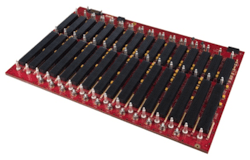Overcoming Signal Bottlenecks in Open VPX Backplanes
Overcoming Signal Bottlenecks in OpenVPX Backplanes
OpenVPXTM solutions have found widespread use in many Defense applications. Combining an open system architecture with high-performance embedded processing has driven advances in radar, EW and other ISR applications such as Wide Area Motion Imagery (WAMI). But, when you examine an OpenVPX system, there is one area that typically is the weakest link – the backplane/payload interconnect.
Processing technology continues to advance, as do switch fabric speeds. And both are scalable. The one area that is starting to top out resulting in throttling back on performance and limiting scalability is the connection between the two. State-of-the-art applications such as AESA radars are pushing data rates beyond 40 Gb/s Ethernet and InfiniBand speeds. Many OpenVPX connectors currently in use show degraded signal integrity performance as data rates approach these speeds. On top of this, data rates are expected to increase further in the near future. This demand for moving data at increasing speeds is driving the need for better technology that enhances or expands subsystem data-channel bandwidth. One such technology is Micro Via Radial Interconnect (MVRI).
MVRI technology addresses this bottleneck by ensuring a reliable signaling rate of 14+Gbaud per channel, even across the most complex subsystems. This enables OpenVPX subsystems to run 40Gb/s Ethernet and FDR InfiniBand™ protocols at full speed, providing superior signal integrity. MVRI improves OpenVPX switch fabric interconnect data rates by increasing the signal integrity margin approximately three-fold, enabling switch fabrics and point-to-point connections to run faster and more reliably. Other solutions have been proposed, but they have not been tested and rely on modeled data. MVRI has been implemented and is in service. As such, it provides a high Technology Readiness Level (TRL).
Below are two figures from laboratory testing of backplane interconnects. Figure 1 shows a degraded signal “eye” plot typical of interconnects that don’t use MVRI as data rates approach 40 Gb/s Ethernet. Figure 2 shows the test results from the same test set up using MVRI. Testing on MVRI has been performed across wide temperature ranges and in high vibration environments. Even under these demanding conditions, the MVRI interconnects maintain signal integrity.
Figure 1: Signal “Eye” plot without MVRI
Figure 2: Actual signal “Eye” plot with MVRI
Another benefit of MVRI is scalability. The MVRI technology roadmap supports signaling rates greater than 14 Gbaud per channel and includes future fabrics including InfiniBand Enhanced Data Rate (EDR) and 100Gb Ethernet. It is also fully VITA compliant. And, because MVRI is designed and made in America, it has a secure and trusted supply chain.
MVRI technology is ideally suited to the most challenging EW and C4ISR processing applications. These applications are characterized by their need for low Size, Weight and Power (SWaP), high deterministic data exchange rates across powerful processing clusters, and include applications as diverse as AESA radars, high resolution wide area motion imagery (WAMI) and sophisticated on-platform sensor data exploitation.
Learn more about MVRI here: https://www.mrcy.com/products/switched_fabrics/
Mercury Systems and TE Connectivity partnered to address OpenVPX connector issues, especially fretting which can occur in rugged environments. You can learn more about the connector here.



